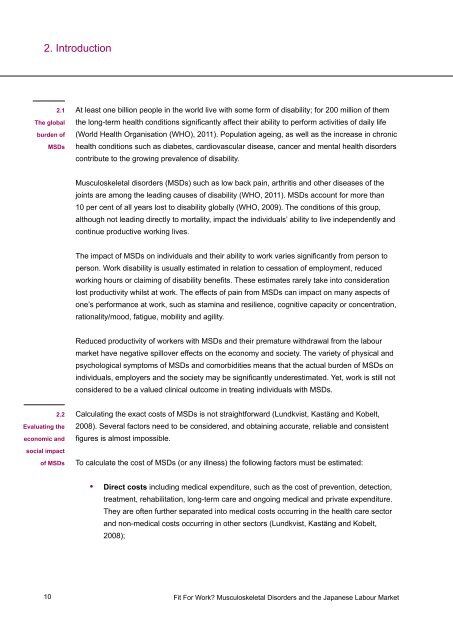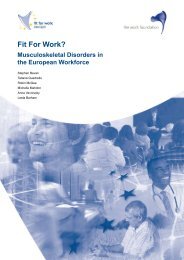English version - Fit for Work Europe
English version - Fit for Work Europe
English version - Fit for Work Europe
You also want an ePaper? Increase the reach of your titles
YUMPU automatically turns print PDFs into web optimized ePapers that Google loves.
2. Introduction<br />
10<br />
2.1<br />
The global<br />
burden of<br />
MSDs<br />
2.2<br />
Evaluating the<br />
economic and<br />
social impact<br />
of MSDs<br />
At least one billion people in the world live with some <strong>for</strong>m of disability; <strong>for</strong> 200 million of them<br />
the long-term health conditions significantly affect their ability to per<strong>for</strong>m activities of daily life<br />
(World Health Organisation (WHO), 2011). Population ageing, as well as the increase in chronic<br />
health conditions such as diabetes, cardiovascular disease, cancer and mental health disorders<br />
contribute to the growing prevalence of disability.<br />
Musculoskeletal disorders (MSDs) such as low back pain, arthritis and other diseases of the<br />
joints are among the leading causes of disability (WHO, 2011). MSDs account <strong>for</strong> more than<br />
10 per cent of all years lost to disability globally (WHO, 2009). The conditions of this group,<br />
although not leading directly to mortality, impact the individuals’ ability to live independently and<br />
continue productive working lives.<br />
The impact of MSDs on individuals and their ability to work varies significantly from person to<br />
person. <strong>Work</strong> disability is usually estimated in relation to cessation of employment, reduced<br />
working hours or claiming of disability benefits. These estimates rarely take into consideration<br />
lost productivity whilst at work. The effects of pain from MSDs can impact on many aspects of<br />
one’s per<strong>for</strong>mance at work, such as stamina and resilience, cognitive capacity or concentration,<br />
rationality/mood, fatigue, mobility and agility.<br />
Reduced productivity of workers with MSDs and their premature withdrawal from the labour<br />
market have negative spillover effects on the economy and society. The variety of physical and<br />
psychological symptoms of MSDs and comorbidities means that the actual burden of MSDs on<br />
individuals, employers and the society may be significantly underestimated. Yet, work is still not<br />
considered to be a valued clinical outcome in treating individuals with MSDs.<br />
Calculating the exact costs of MSDs is not straight<strong>for</strong>ward (Lundkvist, Kastäng and Kobelt,<br />
2008). Several factors need to be considered, and obtaining accurate, reliable and consistent<br />
figures is almost impossible.<br />
To calculate the cost of MSDs (or any illness) the following factors must be estimated:<br />
• Direct costs including medical expenditure, such as the cost of prevention, detection,<br />
treatment, rehabilitation, long-term care and ongoing medical and private expenditure.<br />
They are often further separated into medical costs occurring in the health care sector<br />
and non-medical costs occurring in other sectors (Lundkvist, Kastäng and Kobelt,<br />
2008);<br />
<strong>Fit</strong> For <strong>Work</strong>? Musculoskeletal Disorders and the Japanese Labour Market







